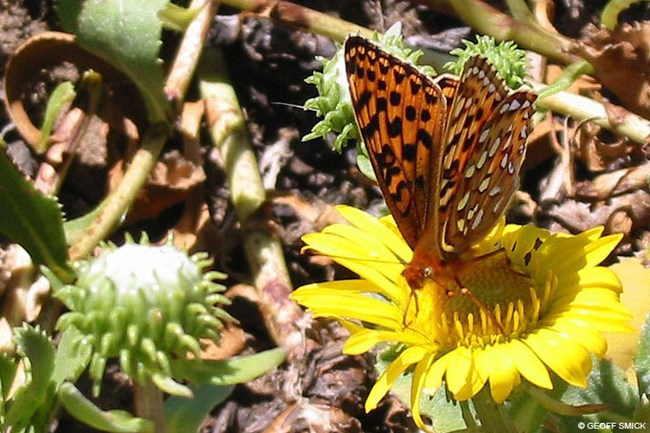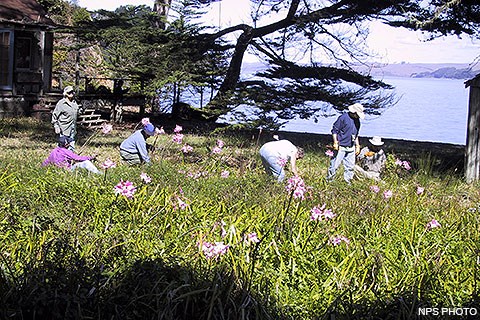The Habitat Restoration Program is Currently InactiveThe Habitat Restoration Volunteer Program at Point Reyes National Seashore was created to inform the public about the great biological diversity that exists here and to include the public into our efforts at preserving it. We believe it crucial that the public realize the tremendous importance of biodiversity both worldwide as well as in our park. Biological diversity is invaluable to every ecosystem; losses of that diversity affect our health, our economy, and all of society in a major way, much more than many of us realize. 
© Geoff Smick What is Biological Diversity…….?Biological diversity is the total number of species of plants and animals in any given area or ecosystem. It is the various manifestations of life, from the minutest amoeba to entire ecosystems such as rainforests and watersheds. It is life in all its many forms and varieties. ...and why is it so valuable?A good way to describe the necessity of biodiversity is to imagine the human body as an ecosystem where the organs correspond to the various species of an ecosystem. If an organ is ailing, it will affect other organs adversely, and then more organs will fail. Similarly, as a particular species goes extinct, those species residing in the same ecosystem also become vulnerable and more extinction will result. The US Forest Service states that each extinction caused by man will result in a chain reaction that causes 30 or more species of plant and wildlife to go extinct.Each species contributes something and is essential to the collective set of life forms known as an ecosystem. A loss at any point in this web of life affects many species, often times devastatingly. Furthermore, humans are part of these ecosystems, relying on them for drinking water, sanitation, pharmaceuticals, and protection from disease and epidemics. Mother Nature has provided our health, wealth, and prosperity; and will continue to do so. To neglect the health of our ecosystems is to neglect our own health. There is no distinction between the future of our environment and our own. Point Reyes is one of the richest pockets of biodiversity in the world.Indeed, Point Reyes Seashore is one of the most biologically diverse places on earth. Conservation International has designated the California Floristic Province, which includes the Seashore, as a "biodiversity hotspot"; one of 25 terrestrial regions of the world where biological diversity is most concentrated and the threat of loss most severe. Invasive plants threaten to destroy the biodiversity at Point Reyes. You can help us protect it.Biodiversity in our park is threatened by invasive plants. These plants leave already vulnerable species of wildlife and plants with no habitat to germinate, spawn or nest. Their chances of survival dwindle as invasive species usurp water, nutrients, and worst of all, their habitat: their home. These invasive plants are the greatest threat to our park’s precious biodiversity. Non-native or exotic plants come from foreign lands and ecosystems and wreak havoc on our once balanced and self-sustaining native ecosystems. Native ecosystems lack natural defenses against these invaders and become subject to their destructive force, driving them towards extinction. Many native populations of humans of the past have been eradicated for this very reason. Foreign pathogens first introduced by Europeans eventually came to destroy entire civilizations that lacked any natural defense. If nothing is done to counter this current invasion, much of our native biodiversity will be lost and never seen again. The park puts enormous effort and assigns great resources in order to counter the effects of these invasive plants. Our task is so encompassing that we ask the public to join us in our efforts to preserve these ecosystems, so that humans, as well as all life forms, may continue to benefit from them for generations to come. We invite you to volunteer...At Point Reyes Seashore, we have a very great need for volunteers. There are thousands of known species here, 131 of which rare, endangered, or threatened. Nearly 20% of the State's flowering plant species are represented on the peninsula and over 45% of the bird species in North America have been sighted here. That's a lot of plant and wildlife to protect, and plenty of habitat to restore. That is why we need you to come and lend a hand. This great and beautiful planet we call our home belongs to all of us and therefore everyone must do his or her part to maintain its vibrance, diversity and health. The greatest opportunity we will ever have to save our planet's ecosystems is right here, right now. Come to Point Reyes and fulfill your sense of stewardship and express your love for the environment. A volunteer will find few places more beautiful, captivating or rich in diversity than Point Reyes National Seashore. The Various Programs of HRVPWe have several projects operating concurrently whose emphasis is the preservation of endangered, threatened or rare plants and animals. We travel to some of the most beautiful areas of the park and breathe in all its wonder while protecting its resources. As a group, volunteers can have a great and positive effect on these endangered species; restoring their habitats and allowing them to survive in their natural settings. Volunteering is a great and healthy way to take in the fresh air and get yourself in shape too! 
The Coastal Restoration CrewThe Coastal Restoration Crew is committed to the preservation of coastal biodiversity through bluff, dune, and stream habitat restoration. These efforts are essential to the protection of many threatened and endangered animals such as the western snowy plover, Myrtle's silverspot butterfly, and the California red-legged frog. Indigenous plants also benefit from our endeavors. Native plant communities support an enormous variety of wildlife here at Point Reyes. The goal of this crew is to insure the rich legacy of these biological communities so that many generations into the future may benefit from them as we do. There are several project areas of the park which are deemed by our resource managers as high priority for the Coastal Restoration Crew. These projects are selected according to the amount of biodiversity contained in the area, including the number of rare, threatened and endangered species, and the magnitude of the threat to that biodiversity. As you have learned already, the greatest threat to our ecosystems are invasive plants. The site of the Abbotts Lagoon Coastal Dune Restoration Project is one of the areas of greatest concern to the park. Endangered plants like the Beach Layia and Tidestrom's Lupine reside here. Myrtle's Silverspot Butterfly, an endangered species, relies on the native plant communities that can be found only on these coastal dunes. The threatened western snowy plover, another lagoon inhabitant, uses the dunes for its nesting grounds. The primary threat to all these species is an invasive plant called European beachgrass. Our efforts to remove this destructive grass range from using heavy machinery to manual labor crews to volunteer groups. Volunteers are essential to our endeavors here at Abbotts Lagoon and we greatly appreciate the continued efforts to this vanishing coastal legacy. Learn more about Coast Dunes: A Vanishing Legacy (375 KB PDF). * The North Beach and Lighthouse sites share many of the same coastal dune plant communities as Abbotts Lagoon. However, these dunes are blanketed not by beachgrass but by the invasive Iceplant. This species of plant may be different than European beachgrass but has the same effect: destruction of habitat. Iceplant creates a carpet across the dunes and makes it impossible for native plants to seed, germinate and thrive. These native plants, in order to survive, require us to remove the Iceplant before it eliminates these plant communities entirely. There are many plants and flowers that thrive in these areas. Riparian Habitat Restoration is focused on the health and diversity of stream and creek ecosystems. In these areas there can be found the endangered California Red-legged Frog, endangered trout and salmon, and the plant communities that support them. The invasive Cape-ivy, originally from South Africa, derives its name from Cape Horn. This plant will grow and suffocate any vegetation including native shrubs, trees, and grasses. Left to its own devices, this plant would destroy any habitat on which it encroaches. This plant poses an eminent threat to our native ecosystems. In a partnership between Golden Gate National Recreation Area and Point Reyes, natural resource managers implement various removal techniques in order to preserve our riparian corridors. These waterways are of enormous value to our local ecosystems; providing habitat for endangered trout and salmon, insuring breeding grounds for amphibians and other aquatic animals, and providing healthy, self-sustaining ecosystems for future generations of plants, animals, and, of course, we humans. How do I volunteer for The Crew?
The Stream TeamThe Stream Team is a group of volunteers dedicated to improving fish habitat through riparian (streamside) restoration. They perform a variety of tasks including willow planting, fence construction, removal and maintenance, non-native plant removal, and ecological monitoring. The Stream Team program runs from December to March, usually meeting on every other Saturday. You can contact the Stream Team coordinator by calling 415-464-5206. * Adobe® Acrobat Reader® may be needed to access "Coast Dunes: A Vanishing Legacy" |
Last updated: May 27, 2024
